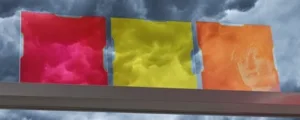The Fraunhofer Institute for Organic Electronics, Electron Beam and Plasma Technology (FEP) will show a coating that enables laser backlighting for holographic displays at SID 2015 (stand 222). SeeReal Technologies in Dresden joined Fraunhofer in the work.
Holographic displays use laser light for a complete 3D display of images. A wide laser beam is required to act as the backlight for an entire display; a conventional set-up would use a large lens system, but these have a complex and costly manufacturing process.
Fraunhofer and SeeReal have developed coatings that can expand the diameter of a laser beam by more than 100. They enable the use of low-power lasers for illumination. The laser is directed at a very flat angle into a glass plate – like a shadow at sunset, this has the effect of increasing the beam’s diameter, turning a small spot into an elongated ellipse. The ellipse then shines on a second glass plate, which elongates the shape’s second direction and expands it to a circle large enough to illuminate the entire display.
However, shining a laser onto an uncoated glass plate at such a flat angle wastes a lot of light – as much as 73% of the beam is reflected. With two steps, as described above, up to 90% of the beam’s intensity could be lost.
An anti-reflective coating was developed that raises the light transmission. Thin layers are deposited on glass using magnetron sputtering. The layers consist of two different materials, with varying optical densities. “Even complicated optical functions can be achieved via multilayer systems, which, for instance, let only certain colours of light pass through, and reflect the others”, said Daniel Glöß of Fraunhofer.
A new precision coating plant (PreSenLine) means that Fraunhofer can use high-precision coating on larger substrates, up to 400 x 300mm.
As in conventional colour TVs, holographic displays have colour created by overlapping RGB layers. 24 layers were required for the anti-reflective coating in Fraunhofer’s demonstration, with thickness levels controlled to within a few nanometers.
Analyst Comment
At the moment, the only way to create a display that covers the full range of the Rec 2020 gamut is using a laser – QDs and other phosphors can’t do it and neither can OLEDs. On that basis, although this technology might seem very exotic, it might be interesting early on for those that really need to have Rec 2020 support. (BR)

